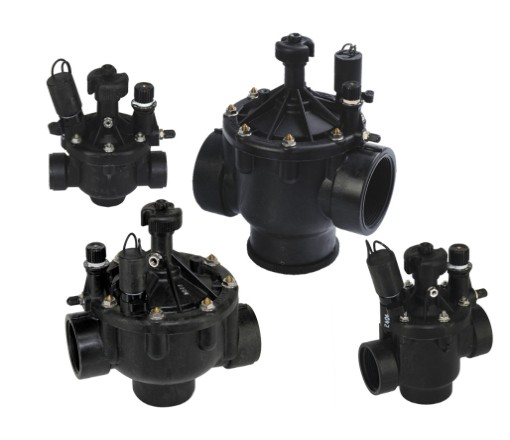Finding water valves that will work for this project is a bit of a challenge. Actually finding valves isn't a huge problem, but finding valves that are affordable is. Here are some of the requirements:
- Support 1.5" to 2.5" hoselines
- Support maximum pressures of at least 250 psi
- Support flows of 150-250 gpm without excessive friction loss
- Cost $100 or less
- Controllable via battery power
A motorized ball valve would be ideal for this project because it would allow the valve to be partially opened or closed. This feature can be used to deliberately introduce additional friction loss, which can simulate additional sections of hose. In addition, motorized ball valves tend to open and close slowly, which minimizes water hammer. However, motorized ball valves in the 1.5" to 2.5" range are very expensive.
Instead, I ended up using a solenoid-controlled valve that was originally intended to be used in in-ground sprinkler systems. Finding a sprinkler valve that could handle the pressure and flow requirements was a challenge, since most sprinkler systems run at much lower pressures than fire hoses. However, the folks at www.sprinklersupplystore.com were great and helped me find the Toro P220 series of valves. These valves are rated to operate at up to 220 psi, which is a little short of my 250 psi goal. However, the 250 psi requirement is mostly just for robustness. Fire hoselines are typically operated at nozzle pressures of 50 to 100 psi. The discharge pressure at the fire truck will be greater in order to overcome the friction loss in the lines at high water flows (100 to 250 gallons per minute), but is still usually under 200 psi unless a very long run of hose is being pumped. Fire pumps are usually rated to go to 250 psi, but rarely do in actual practice. Since the P220 valves have a burst rating of 400 psi, I was ok with using them in this project even though they didn't quite meet the 250 psi operational requirement that I had hoped for. They'll still work to simulate 90% of typical fireground scenarios.

Solenoid valves are "on-off" valves. They can't be partially opened or closed. They operate by way of an electric solenoid that opens or closes a small passageway in the valve, and the water pressure in that passageway is then used to open or close the main waterway. In most lawn sprinkler applications the solenoid is operated by 24VAC, similar to what's used for HVAC controls. Apply 24VAC and the valve turns on, remove voltage and the valve turns off. Generating 24VAC in a portable, battery-powered device is certainly possible, but it makes life a little more complicated. Luckily, there are sprinkler control systems that are designed to run off of 9V battery power. The valves in these systems use a 9VDC latching solenoid instead of the 24VAC solenoid. A latching solenoid is a unique animal. When a 9VDC pulse is applied in one direction, the solenoid activates and latches. The 9V power can then be removed, but the solenoid will stay latched in that position. To switch the solenoid back to the other position, 9VDC is pulsed in the opposite polarity. This is perfect for battery-powered applications, since the solenoid does not continuously draw power when the valve is on, unlike 24VAC solenoids. To switch a 9VDC latching solenoid with a microcontroller, an H-bridge circuit is used. While this is a little bit complicated, it's not nearly as bad as having to generate 24VAC. A future post will detail the H-bridge design and how the valves are controlled.
I ended up using a 1.5" P220 series valve with a 9VDC latching solenoid for the proof of concept design. The part number is P220-26-96. While the 1.5" valve introduces some significant friction loss into the system while operating at typical fire flows, I'm using this to my advantage. By measuring pressure drop across the valve we can calculate flow, which is very useful for training. I'll write another post on friction loss and flow measurements later.
If anyone knows of a valve that would better meet the requirements for this project, leave a comment and let me know!
 andyknitt
andyknitt
Discussions
Become a Hackaday.io Member
Create an account to leave a comment. Already have an account? Log In.